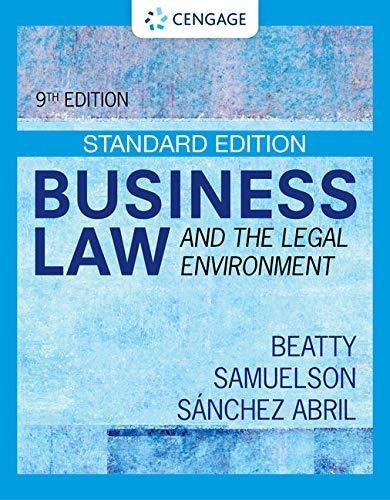Question
Use the following information to answer the following question This passage details the case of Carmen Valdez vs. the City of New York, focusing on
Use the following information to answer the following question
"This passage details the case of Carmen Valdez vs. the City of New York, focusing on the legal principles and rationale underpinning the New York Court of Appeals' decision. Judge Graffeo, writing for the majority, articulates the court's reasoning in affirming the Appellate Division's order, which reversed a jury's verdict in favor of Valdez and dismissed her complaint. The court determined that there was insufficient evidence to establish a "special relationship" between Valdez and the police, which is a prerequisite for the City to owe her a specific duty of care beyond its general duty to the public.
The background of the case involves Valdez securing an order of protection against her estranged boyfriend, Felix Perez, who later shot her. Valdez claimed that a specific phone call with a police officer, in which she was assured of immediate action against Perez, constituted an affirmative duty of care on the part of the City. The court examined the elements required to establish such a special relationship, emphasizing the need for justifiable reliance on the part of the plaintiff on the municipality's affirmative action.
The majority found Valdez's reliance on the police's promise to arrest Perez "immediately" unreasonable, given the circumstances, particularly because she was aware that Perez's whereabouts were unknown at the time of the threat. Furthermore, the decision underscores the principle that the government is not an insurer of individual safety against third-party harms and highlights the limitations imposed by the doctrine of governmental function immunity, which protects public entities from liability for discretionary actions taken in the course of governmental functions.
Chief Judge Lippman dissented, arguing that the majority's interpretation unduly narrows the possibility of establishing a special duty based on reasonable reliance on police action, which, in this case, was both promised and legally required. Lippman's critique suggests that the decision effectively diminishes the potential for holding the government accountable in cases where its specific assurances lead individuals to rely on its protection.
The case reflects the tension between the need to hold governmental entities accountable for their assurances and actions and the principles that limit liability to ensure the government's ability to function without the undue burden of potential litigation. It also touches on broader themes of public safety, individual reliance on law enforcement, and the scope of legal protections available to individuals under threat from others".
Question: If the court had held there was a legal basis to find that the police violated a duty to protect Valdez, for how long and under what conditions would the court likely say that duty existed? Explain.
Step by Step Solution
There are 3 Steps involved in it
Step: 1

Get Instant Access to Expert-Tailored Solutions
See step-by-step solutions with expert insights and AI powered tools for academic success
Step: 2

Step: 3

Ace Your Homework with AI
Get the answers you need in no time with our AI-driven, step-by-step assistance
Get Started


